Home to Round Rock and Georgetown, Williamson County is an up-and-coming suburb of Austin. Travis County and Austin are two of the fastest-growing areas in the United States, which has the benefit of making Williamson County one of the premier destinations to live as well. Williamson County has become an attractive alternative to the crowded Austin and offers a better cost of living to boot. In many ways, the towns of Williamson County capture the feel of what Austin was 20 or more years ago.
As covered previously, Travis County is one of the most expensive property markets in the nation. This has spread to Williamson, though not to the outrageous extent of its neighbor. In 2025, the value of all residential property in the county jumped 6.3% to $104.31 billion according to the Williamson Central Appraisal District (WCAD). With the population and land demand booming, this number is only going to go higher. The only way to lower these values is for landowners to launch property tax protests. About one-third of all property in Williamson County is protested, putting it in the upper tier of Texas counties to do so. O’Connor discusses how effective the first waves of appeals were and how they set the stage for the upcoming season of appeals before the appraisal review board (ARB).
Williamson County Initial Appeals Reduce Home Values by 0.3%
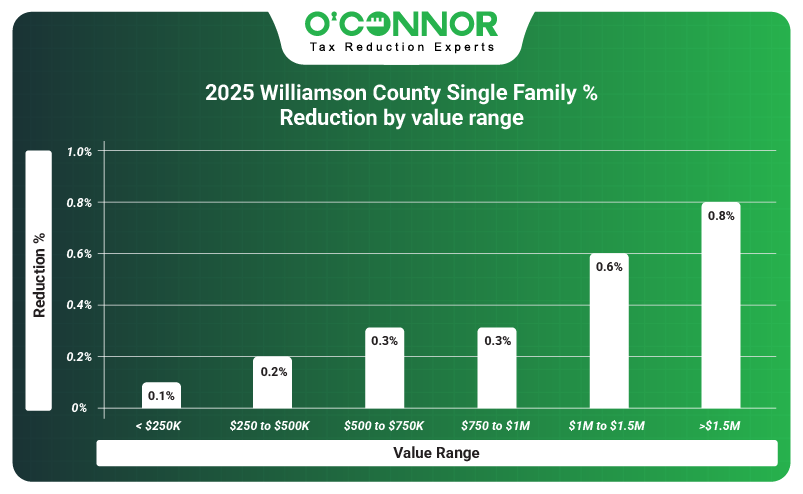
The total value of all homes across Williamson County was calculated as $104.31 billion in 2025, which was an increase of 6.3%. Thanks to the initial round of appeals, 0.3% of this was reduced, leading to a temporary new total of $103.99 billion. $48.48 billion of this value came from homes that were worth between $250,000 and $500,000, the largest block of residential property. The combined value of these homes was lowered by 0.2% thanks to appeals. Homes worth between $500,000 and $750,000 were the second-largest batch and managed to save 0.3%. Homes worth over $1.5 million saw the largest percentage savings at 0.8%, though they only totaled around $3.54 billion in value. Homes worth below $250,000 were the smallest category and only saved 0.1%.
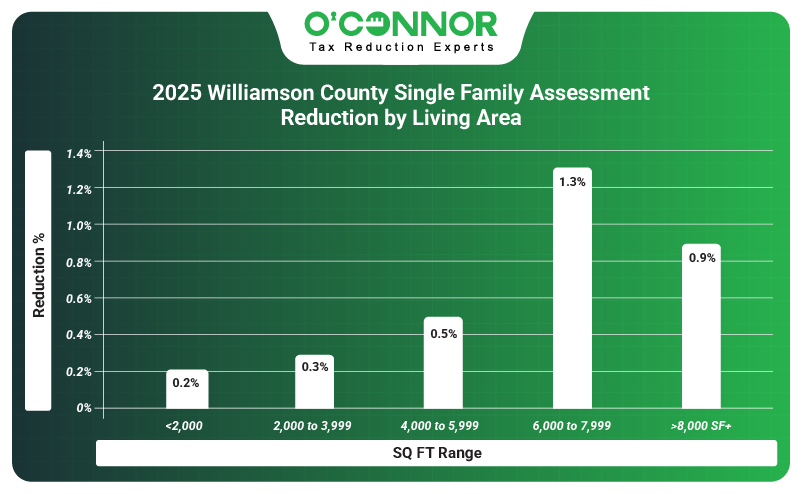
Despite rising values, Williamson County is still a small town at heart. When we look at how value and reductions are distributed when it comes to the size of homes, we can see that most property is still modest. $64.43 billion in value came from homes between 2,000 and 3,999 square feet, while $32.19 billion came from homes below 2,000 square feet. These homes saved 0.3% and 0.2% respectively. This also helps us appreciate the expense of the average Williamson County home when we compare these numbers to those of the previous table. Homes between 4,000 and 5,999 square feet were next in value and got a cut of 0.5%. The largest homes tallied $181.63 million while being reduced by 0.9%.

While Texas as a whole has experienced a huge housing boom since 2000, the Austin area has been the focal point. 52% of all housing value in Williamson County was built between 2001 and 2020, a total of around $54.17 billion. These homes experienced a value cut of 0.3% thanks to early appeals. New construction accounted for 16% of value, before receiving a reduction of 0.4%. Homes constructed between 1981 and 2000 were in the No. 2 spot and got a decrease of 0.2%. Homes built between 1960 and 1980 accounted for only 7% of all value.
Commercial Protests Soffen Historic Spike in Williamson County
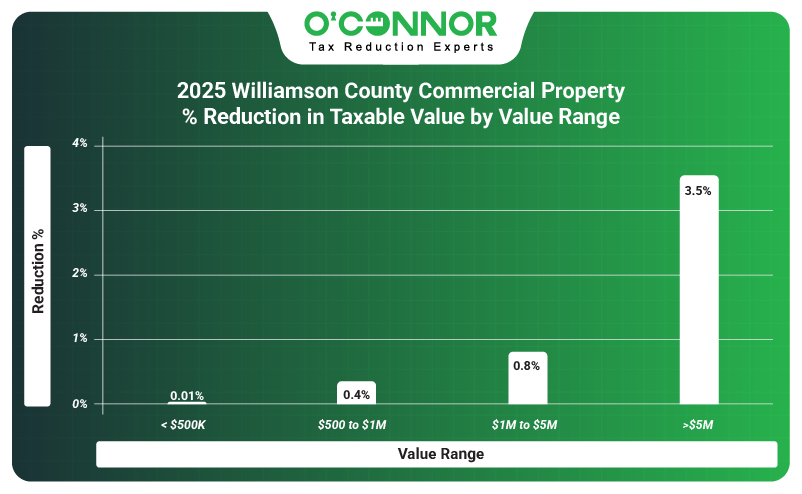
Williamson County experienced a gigantic bump in the value of commercial property in 2025, seeing an increase of 10%. This pushed the total value of all commercial property to $38.73 billion. Appeals were quickly filed in response and the first wave was able to claw back 2.8% of this taxable value. In keeping with most counties across the United States, the majority of value came from the largest of businesses. Those business properties worth over $5 million contributed $29.35 billion, before being reduced 3.5% to $28.33 billion. Commercial property worth between $1 million and $5 million came in second place with a combined value of $7.09 billion, before seeing a reduction of 0.8%. The smallest commercial properties had actually seen a value loss of 6.1% in 2025 and therefore did not see any great value cuts from appeals.

Like most of Texas, the most valuable commercial property type in Williamson County was apartments, with a total of $13.31 before getting a reduction of 3.9%. Raw land was the second-highest, showing the county’s potential. This total of $9.39 billion was slashed by 1.2%. Warehouses saw a staggering 24.4% increase in 2025, before being pared down a bit with 1.9% in reductions. Offices and retail were similar in value, with each getting reductions of 3.1% and 2.8% respectively.
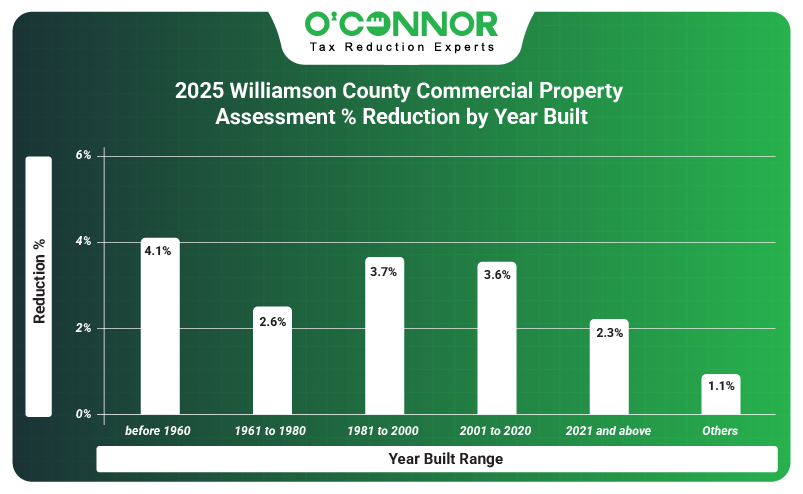
Commercial properties in Williamson County are weighted even more towards recent construction than homes. 38% of all commercial value was built between 2000 and 2021, while 17% was built between 1981 and 2000. These properties received reductions of 3.6% and 3.7% respectively. New construction was responsible for 19% of all value, and this was after receiving a cut of 2.3% thanks to appeals. Older properties constituted around 1% of all value when combined but still saw solid reductions.
Williamson Apartments Land Key Reductions
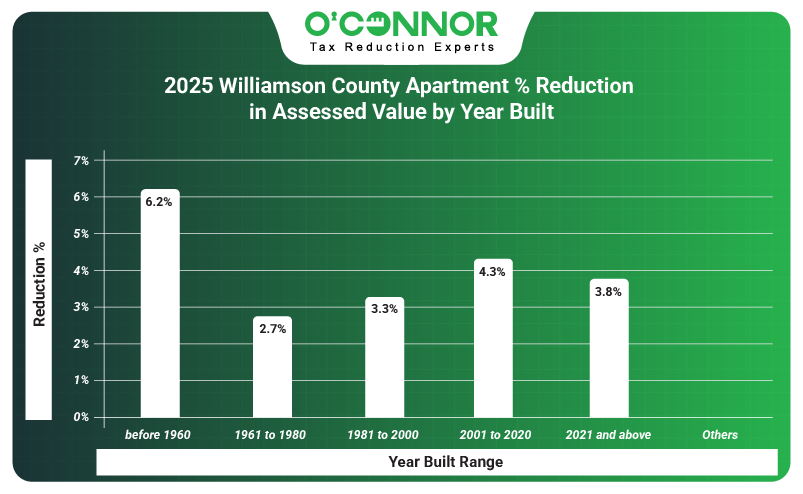
As stated above, apartments are the cornerstone of Williamson County’s commercial value, totaling $14.89 billion in 2025. This number was quickly reduced 3.9% to $14.31 billion thanks to informal appeals, a figure that will decrease drastically after ARB hearings. When it comes to the age of construction, apartments follow the pattern of recent construction even stronger than other property categories we have discussed so far. 50% of all apartment value was built between 2001 and 2020, while 18% was constructed between 1981 and 2000. These large sections of apartments were reduced 4.3% and 3.3% respectively. New construction was responsible for 31% of all value, before getting pulled back by 3.8% thanks to appeals.
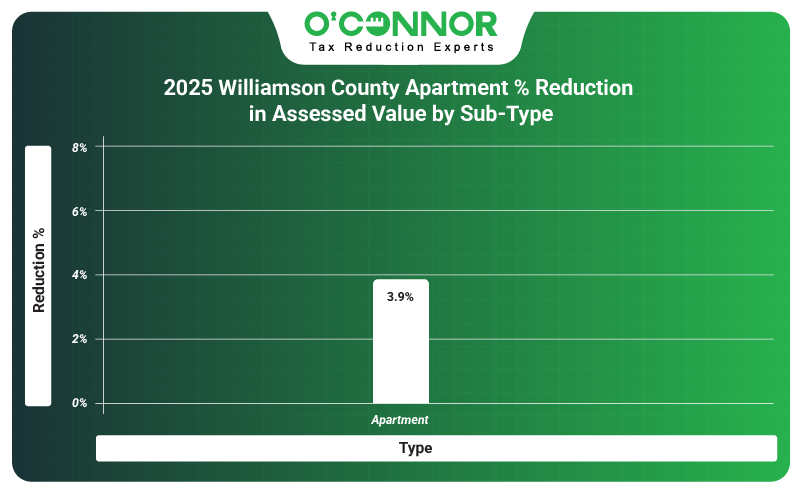
Unlike many other appraisal districts, WCAD does not break down apartments into subtypes. So, no real insight is granted beyond what we have already covered. Apartments were valued at $14.89 billion before being lowered to $14.31 billion thanks to appeals dropping the total by 3.9%.
Williamson County High-Rise Offices Save 4%

Offices rank third behind apartments and raw land when it comes to commercial value in Williamson County, totaling $4.82 billion in 2025. While this was eventually knocked down 3.1% to $4.67 billion, this was still a high-water mark for office value. Like everything else we have looked at, recent construction is the main source of office value. 47% of value was built between 2001 and 2020, while 40% was built between 1981 and 2000. These two categories were reduced by 2.9% and 3.9% respectively, making up most of the cut value. New construction accounted for 9% of all value after being decreased by 0.8%.

Unlike apartments, WCAD actually breaks offices down into a few subtypes. The largest in total value was high-rise offices, which boasted $2.88 billion before appeals were able to shrink it down to $2.77 billion with a reduction of 4%. Medical offices totaled $1.2 billion and then received a reduction of 1.5%. Low-rise offices, fittingly, came in at the bottom of the pecking order with $916.61 million, and this was before landing a cut of 2.2%.
Retail Lands 2.8% Reduction
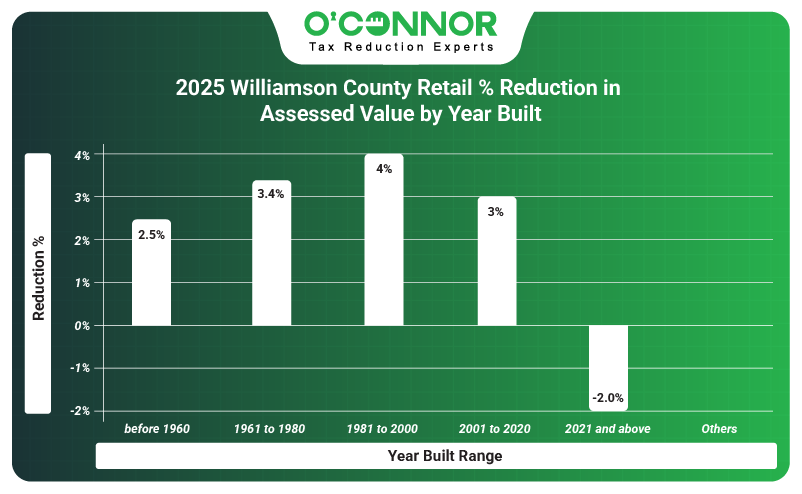
Retail was just edged out by offices for third place in the commercial property hierarchy. With $4.55 billion in total, the 2.8% reduction thanks to appeals produced significant savings. The established pattern of age of construction and value remains unbroken, with retail spaces built between 2001 and 2020 being responsible for 56% of all value. This was followed by 29% of retail properties built between 1981 and 2000. These properties received cuts of 3.0% and 4.0% respectively. New construction was again in third place, with 11% of all value, but somehow managed to land no reductions whatsoever.
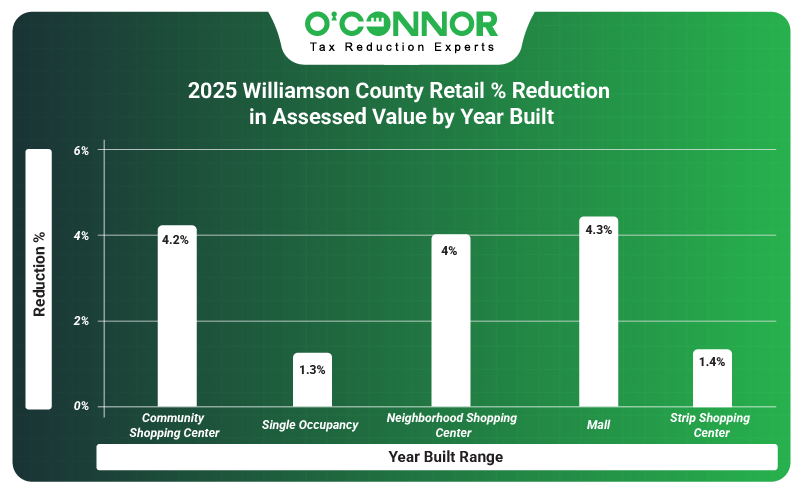
WCAD gives retail a whole list of subtypes to understand how value is spread across retail properties. Strip centers, a favorite in Texas, were in the No. 1 spot with a total value of $1.54 billion, before getting trimmed down 1.4% to $1.52 billion. Malls were a surprising No. 2 retail property, with a total of $1.26 billion, which was then appealed down to $1.20 billion with a 4.3% reduction. Neighborhood shopping centers and single-occupancy retail were next in the pecking order, while also achieving reductions of 4% and 1.3%.
New Construction Rules Warehouses
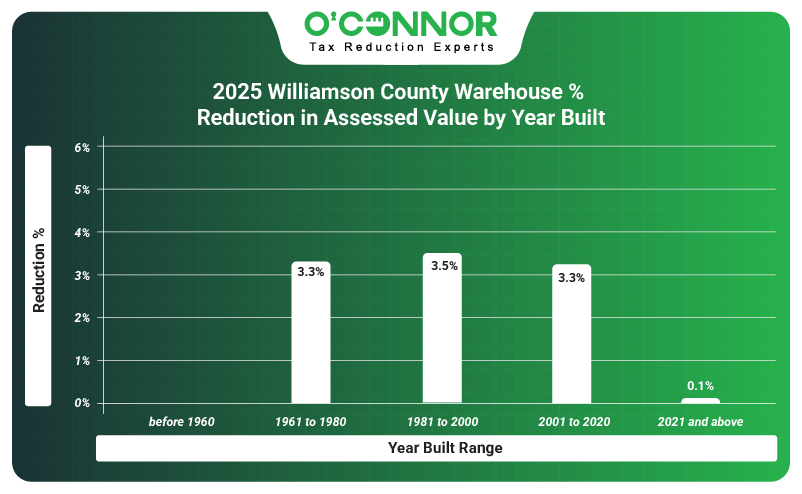
In our final property category, the cycle based on age of construction is finally broken. Newly constructed warehouses came in No. 1 with 47% of the total value. This was thanks to a 32% spike in value for new construction in 2025. This was reduced by only 0.1%, meaning that the meteoric rise in this category’s value went almost untouched. Warehouses constructed between 2001 and 2020 were in second place with 40% of the value and managed a strong reduction of 3.3%. Warehouses constructed from 1981 to 2000 managed to contribute 12% of all value, while bringing home a reduction of 3.5%.
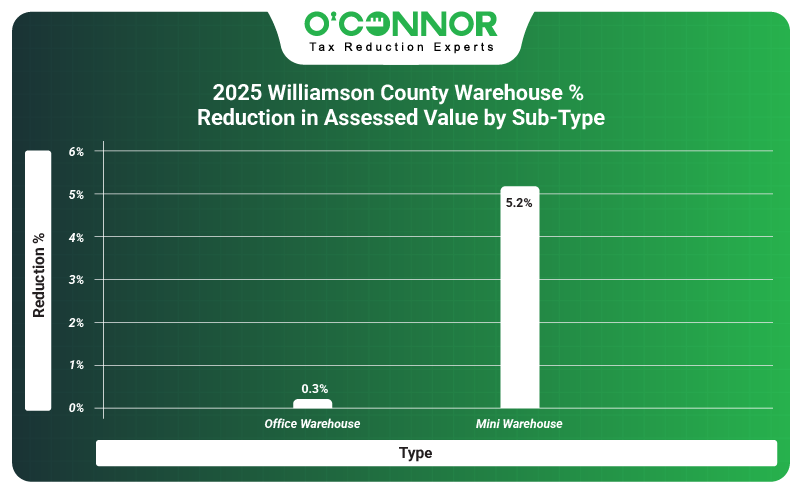
WCAD only breaks warehouses down into office warehouses and mini warehouses. Office warehouses accounted for $2.58 billion of the value, while getting a cut of 0.3%. Mini warehouses totaled $1.22 billion of the $3.74 billion combined value, while achieving a reduction of 5.2%.
Williamson County – Humble Beginnings
At first blush, it seems that property tax appeals came up short against rising values in Williamson County. Given the rapid growth associated with being a suburb of Austin, taxpayers face a significant challenge in contending with the increasingly aggressive property valuations issued by the WCAD. Williamson County is growing like a weed, so much of this estimated growth could be valid, though there is always some overestimation involved. This could certainly be seen as a good thing for taxpayers to an extent, as it means their property values are within reason.
However, currently only informal appeals have been decided. In high-dollar counties, it is usually the ARB hearing portion of the appeal process that yields the most results. This is certainly the case in Travis County, where informal appeals are an afterthought that is just a steppingstone to the ARB. Williamson County is certainly heading in that direction, and with just under one-third of all properties being protested, the formal appeals phase is about to get very crowded. We will return to this at a later date to see how effective the next stage will be for the people of Williamson County.
As you can see it is so important to protest your taxable value. If you are currently going through the ARB process, we can still help you achieve your goals. We at O’Connor have been specializing in property tax protests for over 50 years. As one of the largest firms dedicated to this art, we have the people and resources needed to get the best results. We are based in Houston, Texas and know how best to approach every problem a taxpayer might face in the Lone Star State. Join us and take comfort in the fact that your taxable values will be protested every year. There is no fee to join, and you will only pay if we lower your taxes.

